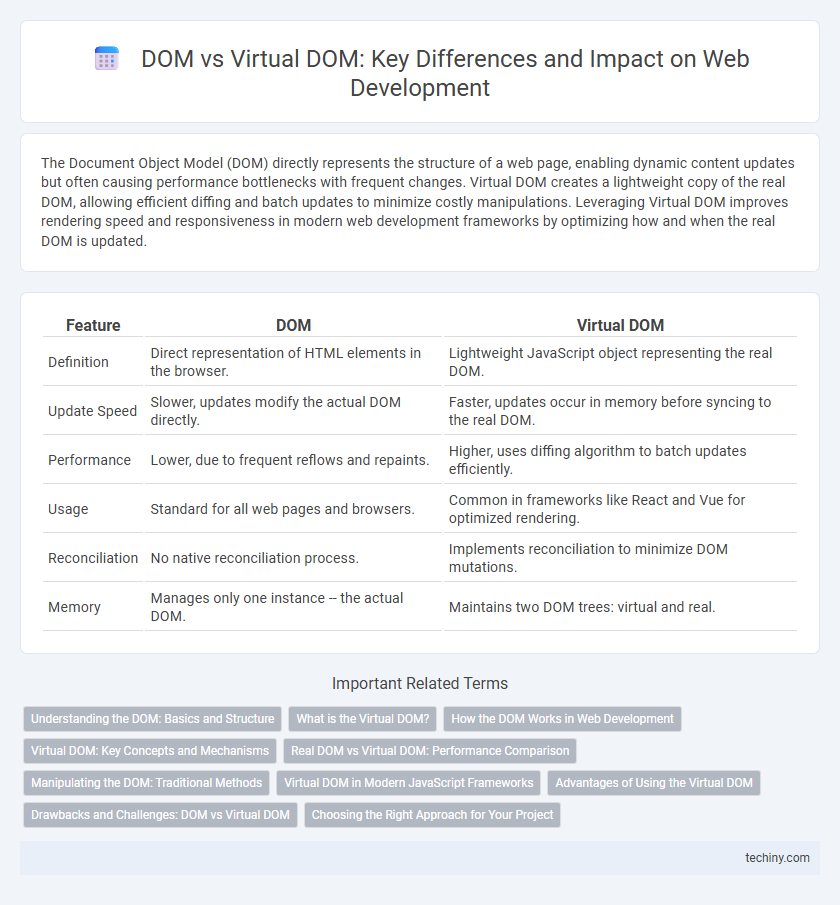The Document Object Model (DOM) directly represents the structure of a web page, enabling dynamic content updates but often causing performance bottlenecks with frequent changes. Virtual DOM creates a lightweight copy of the real DOM, allowing efficient diffing and batch updates to minimize costly manipulations. Leveraging Virtual DOM improves rendering speed and responsiveness in modern web development frameworks by optimizing how and when the real DOM is updated.
Table of Comparison
| Feature | DOM | Virtual DOM |
|---|---|---|
| Definition | Direct representation of HTML elements in the browser. | Lightweight JavaScript object representing the real DOM. |
| Update Speed | Slower, updates modify the actual DOM directly. | Faster, updates occur in memory before syncing to the real DOM. |
| Performance | Lower, due to frequent reflows and repaints. | Higher, uses diffing algorithm to batch updates efficiently. |
| Usage | Standard for all web pages and browsers. | Common in frameworks like React and Vue for optimized rendering. |
| Reconciliation | No native reconciliation process. | Implements reconciliation to minimize DOM mutations. |
| Memory | Manages only one instance -- the actual DOM. | Maintains two DOM trees: virtual and real. |
Understanding the DOM: Basics and Structure
The Document Object Model (DOM) represents the structured hierarchy of HTML elements as a tree, enabling web developers to manipulate web page content dynamically. Each element, attribute, and text node in the DOM corresponds to an object accessible through scripting languages like JavaScript. Understanding the DOM's node-based architecture and event-driven model is essential for efficient web development and effective interaction with the virtual DOM in modern frameworks.
What is the Virtual DOM?
The Virtual DOM is a lightweight JavaScript representation of the actual DOM, allowing efficient updates and rendering by minimizing direct manipulation of the browser's DOM. It acts as an abstraction layer that tracks changes through a diffing algorithm before applying updates in batches, improving web application performance. Frameworks like React utilize the Virtual DOM to enhance user experience by rendering only necessary parts of the UI when the application state changes.
How the DOM Works in Web Development
The Document Object Model (DOM) represents the structure of a web page as a tree of objects, enabling scripts to dynamically access and update content, style, and structure. When a user interacts with a webpage, the browser updates the DOM to reflect changes, which triggers re-rendering of the interface. Efficient manipulation of the DOM is critical for performance, as excessive direct updates can lead to slow page responsiveness and increased rendering time.
Virtual DOM: Key Concepts and Mechanisms
Virtual DOM is a lightweight, in-memory representation of the actual DOM that allows efficient UI updates by minimizing direct manipulation of the browser's DOM tree. It uses a diffing algorithm to compare the previous virtual DOM with the new one, enabling selective rendering of only the components that have changed. This mechanism significantly improves performance and responsiveness in modern web applications by reducing costly DOM operations.
Real DOM vs Virtual DOM: Performance Comparison
Real DOM updates directly manipulate the browser's document structure, causing slower rendering and reflow processes for each change. In contrast, Virtual DOM leverages a lightweight, in-memory tree that batches updates and applies the minimal necessary changes to the Real DOM, significantly improving performance. Frameworks like React optimize UI responsiveness by reducing costly DOM manipulations through efficient diffing algorithms on the Virtual DOM.
Manipulating the DOM: Traditional Methods
Traditional DOM manipulation relies on direct access and modification of HTML elements using methods like getElementById, querySelector, and innerHTML, which can lead to performance bottlenecks due to frequent reflows and repaints. Developers often use event listeners and manual node updates to handle dynamic content, but this approach can be inefficient for complex UI changes. Optimizing traditional DOM manipulation requires minimizing direct updates and batching changes to reduce the computational overhead on the browser's rendering engine.
Virtual DOM in Modern JavaScript Frameworks
Virtual DOM in modern JavaScript frameworks like React and Vue.js enhances performance by minimizing direct manipulation of the browser's Document Object Model (DOM). It efficiently updates only the components that have changed by using a diffing algorithm, reducing rendering time and improving user experience. This abstraction layer enables developers to write declarative code while maintaining fast and responsive interfaces.
Advantages of Using the Virtual DOM
The Virtual DOM enhances web development by improving rendering performance through efficient updates, minimizing direct manipulation of the actual DOM which is notoriously slow. It enables faster user interface changes by batching multiple updates into a single re-render, reducing computational overhead. Frameworks like React leverage the Virtual DOM to provide smoother user experiences and optimize application scalability.
Drawbacks and Challenges: DOM vs Virtual DOM
The traditional DOM suffers from slow updates and reflows, causing performance bottlenecks in dynamic web applications. Virtual DOM addresses this by minimizing direct manipulations and batching changes, but it introduces overhead in diffing algorithms and memory consumption. Developers must balance the performance gains of Virtual DOM with its complexity and resource usage, especially in large-scale applications.
Choosing the Right Approach for Your Project
Choosing between DOM and Virtual DOM depends on project complexity and performance needs; traditional DOM manipulations suit simple applications with minimal state changes, while Virtual DOM excels in dynamic, interactive interfaces due to efficient diffing algorithms that minimize real DOM updates. Frameworks like React leverage Virtual DOM to optimize rendering by comparing virtual representations before applying changes to the browser DOM, reducing reflows and improving user experience. For projects demanding high responsiveness and frequent UI updates, Virtual DOM offers superior scalability, whereas static or server-rendered pages might benefit from the straightforward nature of direct DOM operations.
DOM vs Virtual DOM Infographic

 techiny.com
techiny.com